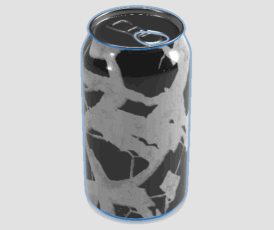Learn about the materials to use on your Dimension project to change the way an object appears.
Dimension is a 3D design tool which acts as a virtual photo studio, allowing you to arrange objects, graphics, and lighting, in the 3D space. 3D includes many types of assets, including the 3D model (the form) and materials (the look). This article covers the basics of materials and supported formats.


Materials change the way objects look. You can use the same material on multiple objects, and different materials on the same object.
Where to find materials
Materials can be created in texturing applications and come in various forms and formats. You can create your own materials, get them from colleagues or clients, or purchase them from a stock service or website. Here are some recommended resources:
Dimension:
The application ships with dozens of common materials available in the Assets panel. These materials are royalty free and can be used for commercial projects. Download Dimension.
Substance Painter:
Substance Painter is a 3D painting application. Here you can import your own 3D models and do detailed custom 3D painting unique for an asset. Download Substance Painter.
Substance Designer:
Substance Designer is a 3D material creation application. Here you can design materials that can be used on many different models such as leather, metal, wood, and much more. Download Substance Designer.
Adobe Stock:
Browse a growing collection of high-quality materials, curated for appearance and quality, and optimized for use in Dimension CC. Browse the 3D content on Adobe Stock.
Substance Source:
Browse a collection of Substances. These Substances are not created specifically for Dimension CC. Browse the 3D content on Substance Source.
Other Sources:
Dimension can import materials created in other applications or purchased from other stock sites.
Images:
In addition to material formats, you can use standard images like Photoshop and Illustrator files to customize the look of your model. See Customizing the Appearance of Models to learn more about how materials and images can be combined.
Supported material formats
Import
- .SBSAR (Substance)
- .MDL (Adobe Standard Material)
- .MTL
.MTL is only supported along with the import of a model and cannot be imported alone. If you have a model with an existing .mtl, just import the model and the .mtl is automatically read along with the .obj as long as the .mtl is in the same folder. Imported .mtl files is converted to the Adobe Standard Material (.MDL) format, so materials may not look identical to other applications.
Export
Dimension does not yet have export capabilities for materials. This is planned for a future release.
Materials and substances overview
Dimension supports two material types: Adobe Standard Material (.MDL) and Substances (.SBSAR). There are a few key differences:
The Adobe Standard Material (.MDL) has one set of properties used to create all of the material variations. No matter which type of material you’re using, for example, wood, metal, leather, plastic, glass, or any other, you get the same properties. Properties can use an absolute value or a texture image. See this article on Adobe standard materials for a list of its properties and controls.


Substances (.SBSAR) are a special type of material created in Substance Designer. Each substance material is specifically crafted so the properties are related to the type of substance. For example, a metal substance material can have scratches, rust, and shine. A fabric substance material can have folds, wrinkles, thread thickness. The author of each substance material decides how they want to build it and which properties should it have so that every substance has a unique set of properties. Substance materials are much easier to edit.




Using materials in your projects
See this article on customizing the appearance of models using materials and images for instructions on how to use materials and images in your Dimension projects.